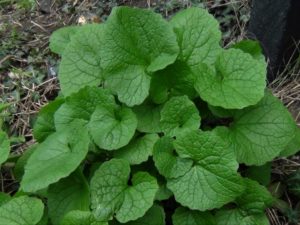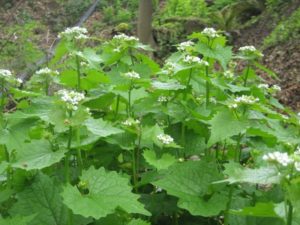Guest Post: Controlling Garlic Mustard in Southeast Iowa
It’s garlic mustard season and it’s very helpful when everyone is armed with information about how to control this invasive plant. Thank you to Jim Peterson for sharing his experience of approximately 10 years working to control garlic mustard on an acreage on Sugar Bottom Road and also in Hickory Hill Park in Iowa City. His hope is to inform and help others who want to control this invasive species.
Garlic mustard is an invasive plant that will crowd out native vegetation in wooded and semi-wooded areas. Total eradication is difficult, since seeds remain viable for years and can be spread in various ways. However, garlic mustard can be controlled by pulling or killing plants each spring before they produce seeds. This can require considerable effort where areas of garlic mustard have become established, but over several years the work needed diminishes each year, and once under control only a modest amount of well-timed attention and work is needed to maintain control.
Garlic mustard is a biennial plant. Seeds germinate and the plant forms a low-growing rosette during the first growing season. In the second season a stalk grows from the middle of the rosette and blooms early in the spring. The flowers produce seeds in mid-to-late summer and these seeds remain viable for several years. Each plant can produce hundreds of seeds. Left uncontrolled, garlic mustard will multiply rapidly and completely cover the ground and crowd out most other plants in a few years.

First year Garlic Mustard

Second year Garlic Mustard
Pulling Garlic Mustard
Garlic mustard is one of the last plants to stop growing in the fall/winter, and one of the first to begin growing in the spring. In late fall or early spring the rosettes that grew during the preceding summer are evident and easy to pull. Rosettes without blooms can be left where they are pulled. After a few warm spring days, stalks with blooms will rapidly grow from each rosette. Once a plant has bloomed, pulled plants must be bagged and disposed of. Plants with blooms will still form seeds, even after being pulled, if they are left behind.
When pulling plants, whether rosettes or blooming plants, it is important to pull as much of the root as possible. If the ground is moist this is usually easily done by grasping at the base of the plant and pulling. If the top of the plant is pulled on or if the ground is dry, the plant will often snap off at ground level. If this happens the root will re-sprout, so it is handy to have a weeding tool to dig out roots when they don’t come out with the rest of the plant.
Garlic mustard plants vary tremendously in size, and small plants will often be found “hiding” under or around
larger plants and some attention must be paid so that all plants are pulled.
After some experience pulling garlic mustard, one learns to identify the just-sprouted seedlings, which can occur in densely packed groups. Sprouts can be very easily be pulled by the dozens or even the hundreds, which will greatly reduce work in the following year.
If pulling is used to control garlic mustard, it helps to go over an area three or four times at intervals of a week or so. It is amazing at how many plants can be missed on the first or second pass!
Chemical Control of Garlic Mustard
Garlic Mustard can also be controlled by spraying plants with RoundUp. The generic name for RoundUp is glyphosate. It is much cheaper to buy generic 41% glyphosate to mix with water than to buy pre-mixed brandname herbicide. When sprayed, glyphosate will kill all actively growing plants, so it should be applied carefully and when there is little or no wind. Be sure to follow the recommended safety precautions.
A 2% glyphosate solution is effective in killing garlic mustard. To make this solution, add 2.5 – 3.0 ounces of 41% glyphosate for each gallon of water. A backpack sprayer that holds around 3 gallons is good for applying glyphosate, but any type of garden sprayer will work. It can be helpful to add spray dye indicator (found at garden centers) to the glyphosate solution, which will show clearly where one is spraying or has sprayed.
Because few other plants are actively growing in late fall or early spring, these can be good times to spray garlic mustard. Note that glyphosate works better at temperatures above 50° F, so warmish fall or spring days are preferred.
Plants that have begun to bloom can also be killed by spraying, but the larger the plant, the more spray is needed. Spraying early is cheaper and more effective than spraying after plants have grown large and bloomed. It will take a week or so to begin to see the results of spraying, and plants will take several weeks to die completely.
Other Control Methods
Cutting dense infestations of garlic mustard will kill some, but not all, of the plants. Use a string cutter and cut them off as low as possible. If plants have bloomed, bag the cut flower stalks and dispose of them. You may have to cut more than once in a season; some plants will re-bloom after a first cutting.
Burning with a propane torch does not work well for rosettes or flowering plants, but can be used to kill just sprouted seedlings if areas with sprouts are evident.
Prescribed fire may be used to control garlic mustard, but timing is critical and effectiveness can vary. In addition, use of prescribed fire should be overseen or directed by an experienced professional.
Final Thoughts
Pulling or spraying garlic mustard can be a good way to observe and get to know a woodland on much more intimate basis than one would otherwise. Learning to identify trees and shrubs, seeing wildlife, enjoying spring wildflowers and happening upon weird fungi are just a few of the perks of working in the woods.
While working to control garlic mustard, one can also get to know a variety of other invasive plants and develop plans, methods and techniques for controlling them. Honeysuckle, autumn olive, oriental bittersweet, multiflora rose, winged euonymus and Japanese barberry – these are all species that we should learn to identify and help to eliminate before they become established. Local ecosystems have few defenses against these invaders, and everyone can play a part in keeping them at bay.


